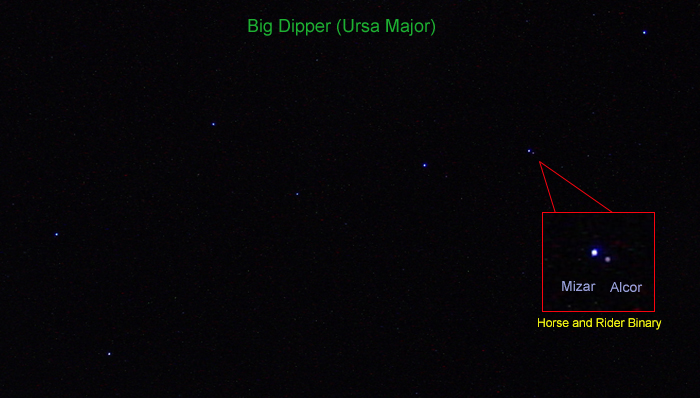Mizar and Alcor
- This is an article about the star, for other uses please see Mizar (disambiguation)
| Observation data Epoch J2000 Equinox J2000 | |
|---|---|
| Constellation | Ursa Major |
| Right ascension | 13h 23m 55.5s |
| Declination | +54° 55′ 31″ |
| Apparent magnitude (V) | 2.23 |
| Characteristics | |
| Spectral type | A2 V/A2 V/A1 V |
| U−B color index | 0.09 |
| B−V color index | 0.13 |
| Variable type | ? |
| Astrometry | |
| Radial velocity (Rv) | −9 km/s |
| Proper motion (μ) | RA: 121.23 mas/yr Dec.: −22.01 mas/yr |
| Parallax (π) | 41.73 ± 0.61 mas |
| Distance | 78 ± 1 ly (24.0 ± 0.4 pc) |
| Absolute magnitude (MV) | 0.33 |
| Other designations | |
Mizar (ζ UMa) is a star in the constellation Ursa Major and is the second star from the end of the Big Dipper's handle. The name comes from the Arabic ميزر mi'zar, meaning a waistband or girdle. Mizar has apparent magnitude 2.27 and spectral class A1 V.
With good eyesight one can make out a faint companion just to the east, called Alcor or 80 Ursae Majoris. Alcor has magnitude 3.99 and spectral class A5 V. The two are often called the horse and rider, and the ability to see the second is a traditional test of eyesight. The two stars lie more than a quarter of a light year apart and although proper motions show they move together, it is still not known whether they form a true binary star system, and not an optical binary as currently thought.
More components were discovered with the advent of the telescope and spectroscopy; a fine, easily-split visual target, Mizar was the first telescopic binary discovered--most probably by Benedetto Castelli who in 1617 asked Galileo Galilei to observe it. Galileo then produced a detailed record of the double star. Later, around 1650, Riccioli wrote of Mizar appearing as a double. The secondary star, Mizar B, has magnitude 4.0 and spectral class A7, and comes within 380 AU of the primary; the two take thousands of years to revolve around each other. Mizar A then became the first spectroscopic binary to be discovered, by Pickering in 1889. The two components are both about 35 times as bright as the sun, and revolve around each other in about 20 days. Mizar B was later found to be a spectroscopic binary as well. In 1996 the components of the Mizar A binary system were imaged in extremely high resolution using the Navy Prototype Optical Interferometer.
| Observation data Epoch J2000.0 Equinox J2000.0 | |
|---|---|
| Constellation | Ursa Major |
| Right ascension | 13h 25m 13.5s |
| Declination | +54° 59' 17" |
| Apparent magnitude (V) | +3.99 |
| Absolute magnitude (V) | +2.01 |
| Distance | 81.2 ± 1.2 ly (24.9 ± 0.4 pc) |
| Spectral type | A5V |
| Other designations | |
The whole five-star system lies about 78 light-years away from us. The components are all members of the Ursa Major moving group, a mostly dispersed group of stars sharing a common birth, as determined by proper motion. The other stars of the Big Dipper, except Dubhe and Alkaid, belong to this group as well.
See also
External links
- Mizar and Alcor articles in Jim Kaler's Stars website
- First very high resolution imaging of Mizar A (using aperture synthesis)

